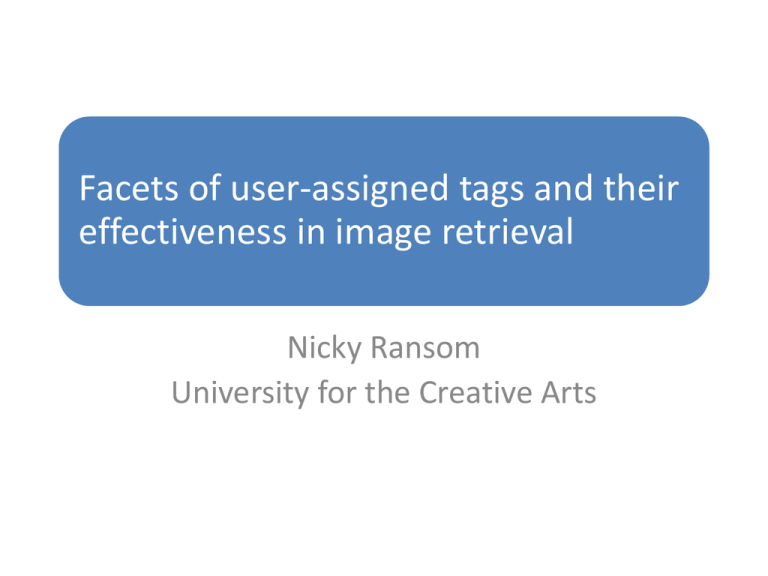Facets of user-assigned tags and their effectiveness in image
advertisement

Facets of user-assigned tags and their effectiveness in image retrieval Nicky Ransom University for the Creative Arts Tags Election night crowd, Wellington, 1931 Photographer: William Hall Raine Election night crowd, Wellington, 1931 Reference number: 1/2-066547-F Original negative Photographic Archive, Alexander Turnbull Library •William Hall Raine •crowd •men •hats •street •night •lighting •faces •sea of people •people •watching •event •election •results •populated Background to research topic • Growth in number of images online • Accurate and comprehensive indexing is critical to make online content accessible • But visual materials are difficult to index Approaches to image indexing • Concept-based indexing – assigning index terms to describe the subject of an image Approaches to image indexing • Concept-based indexing – assigning index terms to describe the subject of an image • Search engine indexing – index terms automatically created from data related to an image Approaches to image indexing • Concept-based indexing – assigning index terms to describe the subject of an image • Search engine indexing – index terms automatically created from data related to an image • Content-based indexing – using automatic processing to index image attributes such as colour, texture and shape CIRES: Content Based Image REtrieval System User tagging Research question To find out value of tags for image retrieval by investigating whether the terms used to describe images in tags are similar to the terms used to search for images. – Which image facets are described in user tags? – How do these compare to those found in image queries? – What are the implications for future use of tagging for online indexing? Shatford’s matrix Who? What? Where? When? Specific Generic Abstract Individually named person, group or thing (S1) eg Napoleon Kind of person, group or thing (G1) Mythical or fictitious being (A1) eg Skyscraper eg King Arthur Individually named event or action (S2) Kind of event, action or condition (G2) Emotion or abstraction (A2) eg London Olympics eg Football game eg Anger Individually named geographical location (S3) eg New York Kind of place: geographical or architectural (G3) eg Forest Place symbolised (A3) Linear time: date or period (S4) Cyclical time: season or time of day (G4) eg 2010 eg Spring Emotion/abstraction symbolised by time (A4) eg Father Time eg Paradise Armitage, L., & Enser, P. (1997). Analysis of user need in image archives Journal of Information Science, 23(4), 287-299. Research methodology • Small scale study using 250 images and associated tags on Flickr • Tags categorised using facets from ‘Shatford’s matrix’ • Comparisons made with results of previous research into user queries Comparison of tags and queries (1) Comparison of tags and queries (2) Comparison of tags and queries (3) Factors affecting results • Limited sample size – only 250 images • Use of Flickr as domain for study – only 38% of users apply tags • Subjectivity of categorising tags – only one person assigning tags to categories • Suitability of Shatford’s matrix – 22% of terms could not be categorised • Lack of online query studies with which to compare the results Conclusion • Broad similarities between the image facets used in queries and image tags • But differences in the level of specificity • Need to develop systems to bridge this gap • Consider the value of tags for browsing systems






